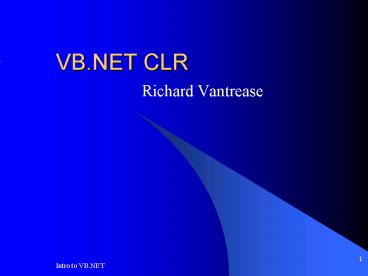VB'NET CLR - PowerPoint PPT Presentation
1 / 13
Title:
VB'NET CLR
Description:
The .NET Common Language Runtime (CLR) is the language runtime that all of the. ... Modules are some of the files that make up an assembly (EXEs and DLLs) ... – PowerPoint PPT presentation
Number of Views:55
Avg rating:3.0/5.0
Title: VB'NET CLR
1
VB.NET CLR
- Richard Vantrease
2
Introduction
- The .NET Common Language Runtime (CLR) is the
language runtime that all of the .NET languages
use. VB used to require its own runtime files. - msvbvm60.dll was the main runtime file for VB 6.0.
3
Vocabulary
- Assemblies (DLL or EXE)
- Manifest
- Modules
- Types
- .NET Metadata
- Attributes
- Deployment
- Managed Code
- Finalize Method
- Garbage Collector
- Managed Heap
4
Assemblies
- An assembly is the primary unit of deployment for
a .NET application. - Assemblies contain modules, a manifest and
resource files. - Assemblies can only have one manifest.
5
Modules
- Modules are some of the files that make up an
assembly (EXEs and DLLs). - Modules contain types (similar to classes in
VB6), metadata, and optionally the assembly
manifest. - Types are made up of Fields, Methods and
Properties.
6
.NET Assembly Manifest
- Manifest is stored in an EXE, DLL or a standalone
portable execution (PE) file. - The manifest contains assembly metadata.
- The assembly manifest
- Lists files that make up the assembly
- Maps location of types and resources
- Enumerates other assembly dependencies
- Self describes the assembly
7
Deployment
- Deployment of a VB.NET assembly is much easier
than deploying a VB6 application. - VB.NET assemblies are self describing and
therefore do not need to be registered. The .NET
framework searches for referenced assemblies
automatically. - .NET also supports side by side execution (use of
different versions of the same component).
8
Managed Code
- Managed code is any code that executes in the
CLR. - Code which is not in the .NET framework and does
not use the CLR is un-managed code.
9
Garbage Collector
- The garbage collector (GC) periodically goes
through all the objects in use by the CLR and
eliminates or destroys the ones that no longer
are in use. - The GC, not the programmer, determines when an
object is destroyed. - The GC uses nondeterministic finalization.
10
Finalize Method
- Object.Finalize is the method that the GC calls
immediately before collecting and destroying the
object. - Sometimes it is necessary to override the
finalize method in order to free up expensive
resources or to more closely control the time
when object clean-up occurs.
11
Overriding The Finalize Method
- Protected Overrides Sub Finalize()
- Cleanup code goes here
- End Sub
- Suppress normal finalize call
- GC.SuppressFanalize(Me)
12
Managed Heap
- The CLR uses the GC to manage the heap.
- The heap is where objects are created in memory.
- The .NET CLR uses a managed heap which means it
keeps track of the objects allocated in the heap.
13
Heap Optimizations
- Objects that are allocated on the heap are
assigned generations (0 2). - Each time the GC runs if it does not collect an
object, the objects generation is incremented. - The GC tries to collect objects with the lowest
generation numbers first. - When the GC is done collecting objects it
compacts the heap so it does not become
fragmented.































